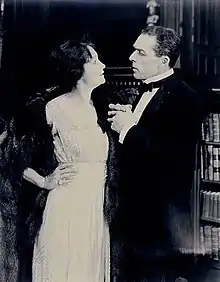The Man Who Lost Himself (1920 film)
The Man Who Lost Himself is a lost[1] 1920 American silent comedy drama film directed by Clarence G. Badger and George D. Baker. It was produced by its star, stage actor William Faversham, and Lewis J. Selznick. The film is based on a story by Henry De Vere Stacpoole.[2][3] Faversham plays dual roles of an English nobleman and an American who looks just like him.
| The Man Who Lost Himself | |
|---|---|
 Hedda Hopper and William Faversham | |
| Directed by | Clarence G. Badger George D. Baker |
| Produced by | William Faversham Lewis J. Selznick |
| Written by | Henry De Vere Stacpoole (story) George D. Baker |
| Starring | William Faversham Hedda Hopper |
| Cinematography | Lucien N. Andriot |
| Distributed by | Selznick Pictures |
Release date | May 30, 1920 |
Running time | 50 minutes |
| Country | United States |
| Language | Silent (English intertitles) |
Plot
As described in a film magazine,[4] American Victor Jones (Faversham) finds himself penniless and stranded in London. He meets the Earl of Rochester (Faversham), and the similarity between the two is so noticeable that even friends mistake Jones for the Earl. The Earl is estranged from his wife (Hopper) and family, owes great sums of money, and is considered in a bad light by acquaintances. He gets Jones drunk and sends him to the Rochester mansion, and then commits suicide. Until Jones receives a note written by the Earl prior to his death, he does not perceive his position. After reading the note, Jones immediately begins to pose as the Earl, but later reveals this scheme. However, he has fallen in love with the Earl's widow and they decide to reside in the United States.
Cast
- William Faversham as Victor Jones / Earl of Rochester
- Hedda Hopper as Countess of Rochester
- Violet Reed as Lady Plinlimon
- Radcliffe Steele as Sir Patrick Spence
- Claude Payton as Prince Maniloff
- Mathilde Brundage as Rochester's Mother
- Emily Fitzroy as Rochester's Aunt
- Downing Clark as Rochester's Uncle
Reception
According to The New York Times reviewer, provided the viewer could accept that an American, with no prior knowledge of the Englishman's life, could pass for him, "Any one disposed to make the necessary assumptions may, and undoubtedly will, enjoy the photoplay, for the two leading rôles are played by William Faversham with unfailing pantomimic ability and sureness of characterization."[5]
References
- The Library of Congress American Silent Feature Films Survival Catalog: The Man Who Lost Himself
- Progressive Silent Film List: The Man Who Lost Himself at silentera.com
- The AFI Catalog of Feature Films: The Man Who Lost Himself
- "Reviews: The Man Who Lost Himself". Exhibitors Herald. New York City: Exhibitors Herald Company. 10 (26): 85–86. June 26, 1920.
- "The Screen". The New York Times. May 31, 1920.